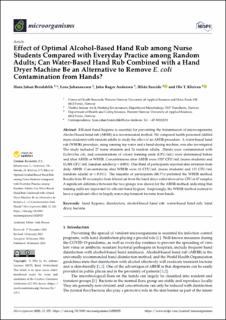| dc.contributor.author | Breidablik, Hans Johan | |
| dc.contributor.author | Johannessen, Lene | |
| dc.contributor.author | Andersen, John Roger | |
| dc.contributor.author | Søreide, Hilde | |
| dc.contributor.author | Kleiven, Ole Tormod | |
| dc.date.accessioned | 2023-08-31T10:15:08Z | |
| dc.date.available | 2023-08-31T10:15:08Z | |
| dc.date.created | 2023-03-10T17:14:43Z | |
| dc.date.issued | 2023 | |
| dc.identifier.citation | Microorganisms. 2023, 11 (2), 1-12. | en_US |
| dc.identifier.issn | 2076-2607 | |
| dc.identifier.uri | https://hdl.handle.net/11250/3086588 | |
| dc.description.abstract | Efficient hand hygiene is essential for preventing the transmission of microorganisms. Alcohol-based hand rub (ABHR) is a recommended method. We compared health personnel (skilled nurse students) with random adults to study the effect of an ABHR procedure. A water-based hand rub (WBHR) procedure, using running tap water and a hand-drying machine, was also investigated. The study included 27 nurse students and 26 random adults. Hands were contaminated with Escherichia coli, and concentrations of colony forming units (CFU/mL) were determined before and after ABHR or WBHR. Concentrations after ABHR were 1537 CFU/mL (nurse students) and 13,508 CFU/mL (random adults) (p < 0.001). One-third of participants reported skin irritation from daily ABHR. Concentrations after WBHR were 41 CFU/mL (nurse students) and 115 CFU/mL (random adults) (p < 0.011). The majority of participants (88.5%) preferred the WBHR method. Results from 50 air samples from filtered air from the hand dryer outlet showed no CFU in 47 samples. A significant difference between the two groups was shown for the ABHR method, indicating that training skills are important for efficient hand hygiene. Surprisingly, the WBHR method seemed to have a significant effect in largely removing transient bacteria from hands. | en_US |
| dc.language.iso | eng | en_US |
| dc.publisher | MDPI | en_US |
| dc.rights | Navngivelse 4.0 Internasjonal | * |
| dc.rights.uri | http://creativecommons.org/licenses/by/4.0/deed.no | * |
| dc.title | Effect of Optimal Alcohol-Based Hand Rub among Nurse Students Compared with Everyday Practice among Random Adults; Can Water-Based Hand Rub Combined with a Hand Dryer Machine Be an Alternative to Remove E. coli Contamination from Hands? | en_US |
| dc.type | Peer reviewed | en_US |
| dc.type | Journal article | en_US |
| dc.description.version | publishedVersion | en_US |
| dc.rights.holder | © 2023 by the authors | en_US |
| dc.source.pagenumber | 1-12 | en_US |
| dc.source.volume | 11 | en_US |
| dc.source.journal | Microorganisms | en_US |
| dc.source.issue | 2 | en_US |
| dc.identifier.doi | 10.3390/microorganisms11020325 | |
| dc.identifier.cristin | 2133187 | |
| cristin.ispublished | true | |
| cristin.fulltext | original | |
| cristin.qualitycode | 1 | |

